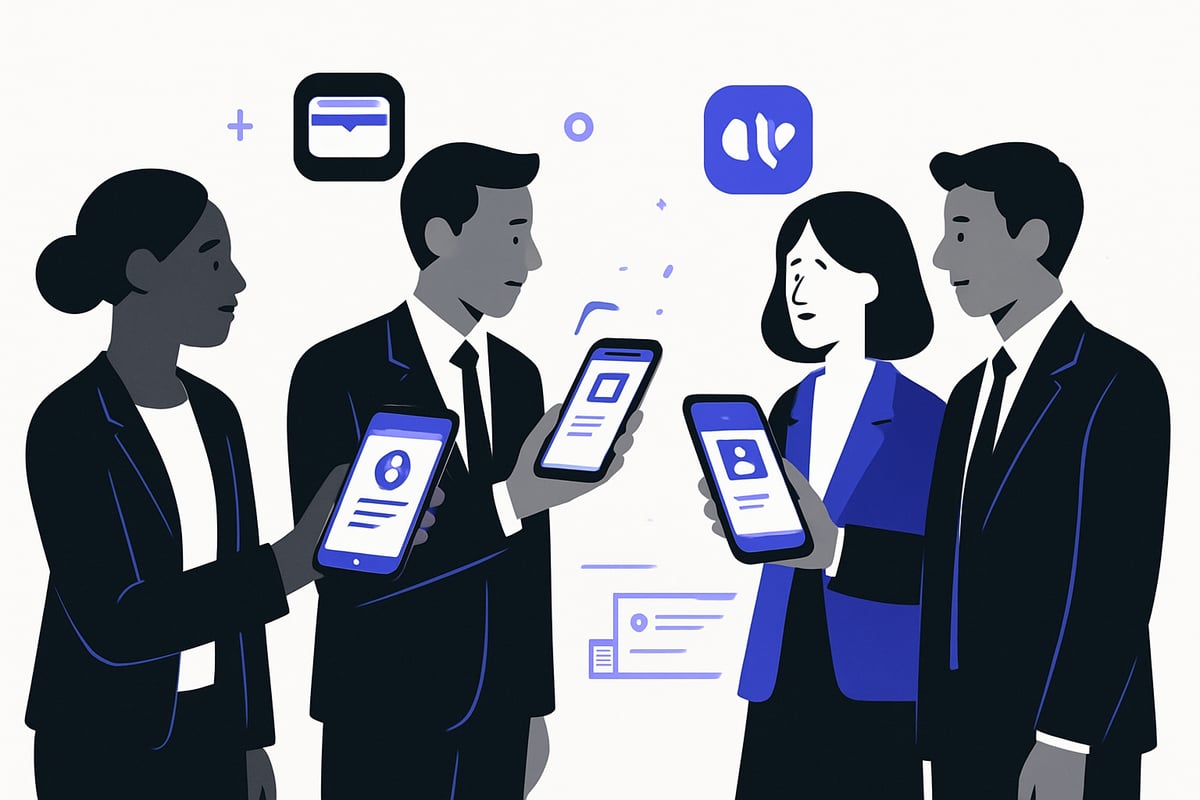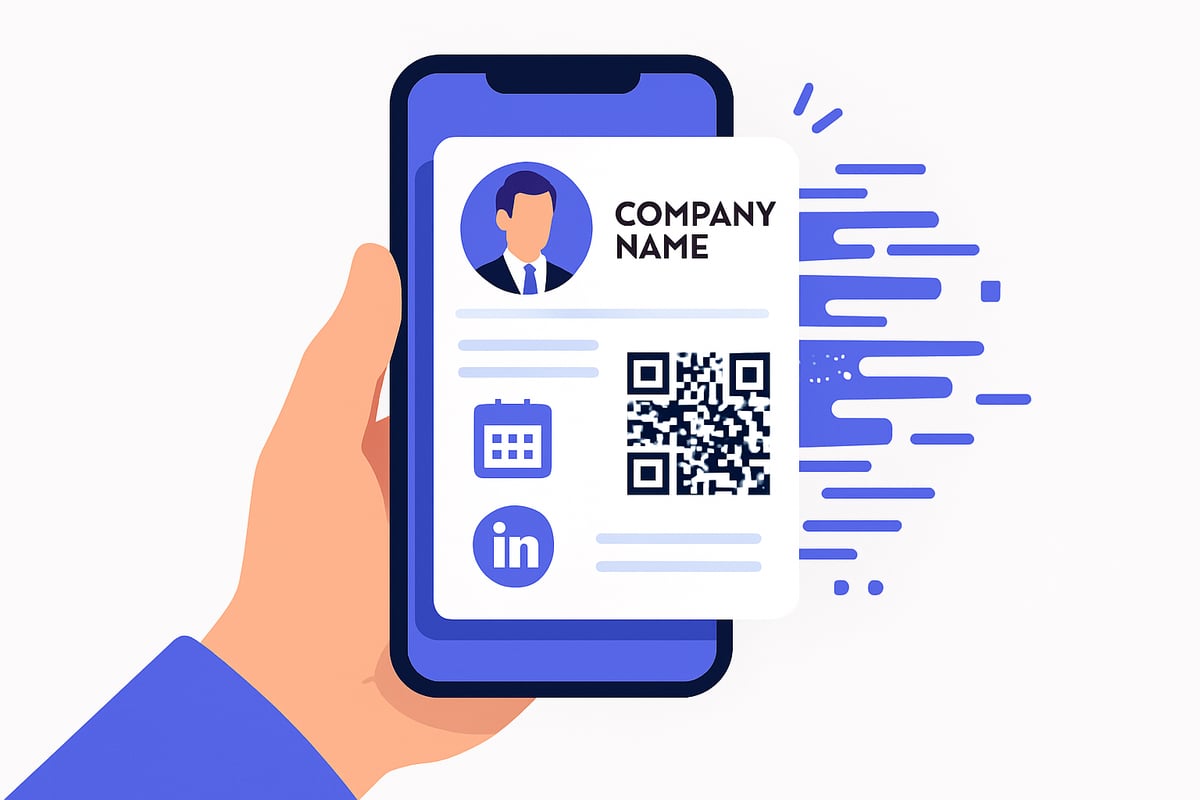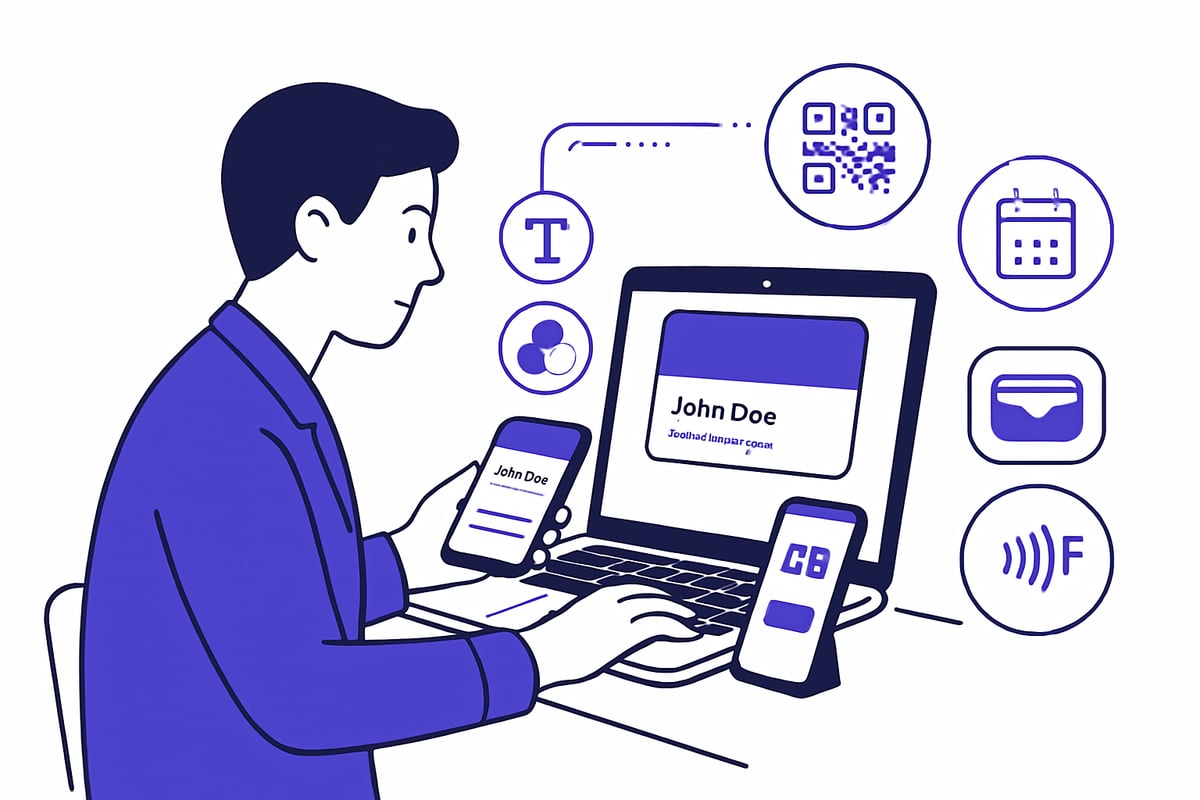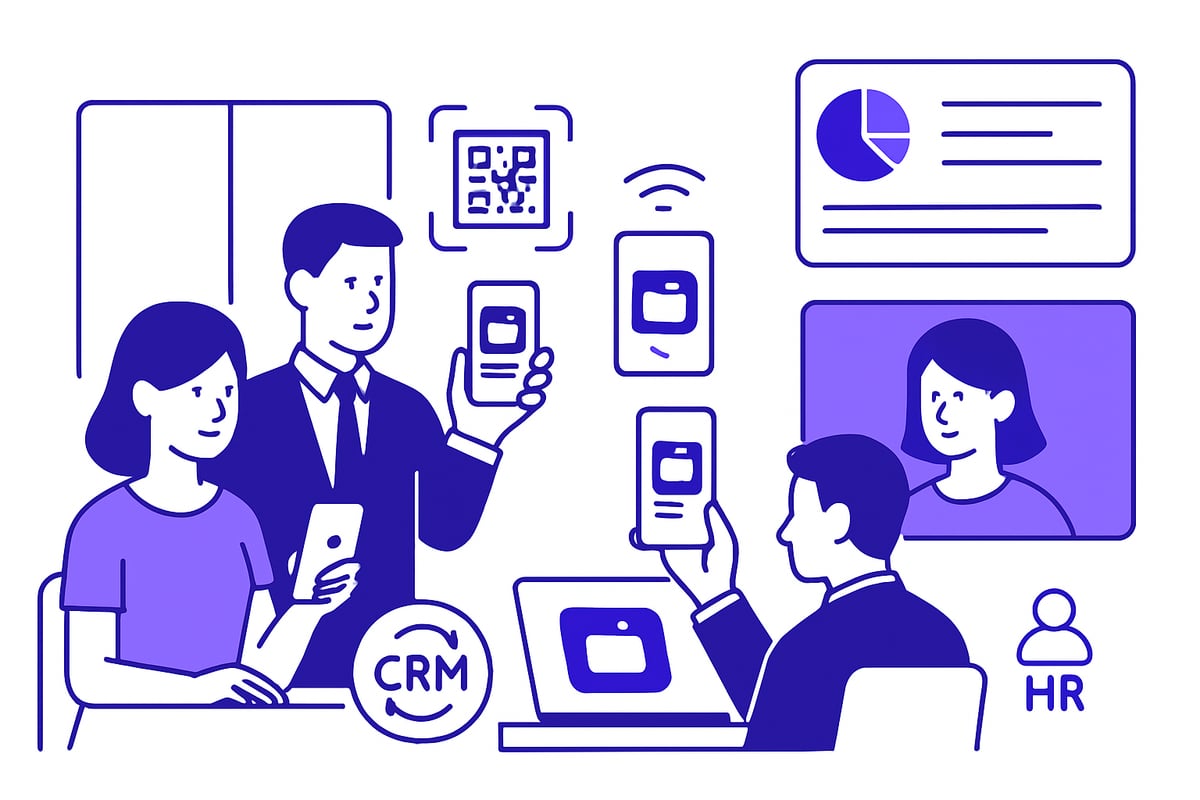Wallet Business Card Guide: Stand Out in 2025
13 minutes
11th of October 2025
In this article:
- The Rise of Wallet Business Cards in 2025
- What Makes a Wallet Business Card Stand Out?
- Step-by-Step Guide: Creating Your Wallet Business Card
- Integrating Wallet Business Cards into Your Workflow
- Future Trends: The Evolution of Wallet Business Cards
In a world where first impressions happen in seconds, your wallet business card can make all the difference. As professionals move beyond traditional paper cards, digital wallet business cards offer a smarter way to connect—always accessible, interactive, and easy to update.
These cards help you stand out, streamline networking, and increase follow-ups in 2025. This article is your step-by-step guide to creating, customizing, and maximizing wallet business cards for impact. You’ll learn what they are, why they matter now, how to build your own, advanced customization, integration tips, and future trends.
The Rise of Wallet Business Cards in 2025
The landscape of professional networking is undergoing a rapid digital transformation. As we move into 2025, the wallet business card has become a symbol of modern, tech-savvy communication. With just a tap or scan, professionals can now share their credentials instantly, leaving a memorable impression and streamlining every connection.

Digital business cards are quickly replacing their paper counterparts, driven by the need for efficiency and sustainability. According to recent digital business card adoption statistics, over four million cards were shared in the past year, with engagement rates rising by 38% and follow-up actions increasing by 630%. This surge highlights a shift in how professionals exchange and manage contact information, making the wallet business card a vital tool for networking success.
What makes the wallet business card so compelling? Unlike traditional cards, digital versions offer instant updates—no more outdated phone numbers or titles. They can be refreshed in real time, ensuring every recipient always has your latest details. Additionally, wallet business cards are eco-friendly, supporting the growing demand for sustainable business practices by eliminating paper waste and reducing the carbon footprint.
Interactivity is another game-changer. Wallet business cards can include dynamic features such as clickable links, embedded videos, and even lead capture forms. These elements drive deeper engagement and make your information actionable on the spot. Apple Wallet and Google Wallet have further enabled this revolution, allowing users to save and access business cards seamlessly from their phones. Sharing is as simple as a QR code scan or a tap, making in-person and virtual networking frictionless.
Industries across the globe are already embracing this shift. Leading brands like American Express GBT, TeamViewer, and Volkswagen Financial Services have adopted wallet business cards to modernize their networking processes. In the financial sector, for example, secure digital cards ensure compliance and up-to-date information for every client interaction. Technology companies are leveraging wallet business cards to showcase demos, portfolios, and scheduling links, all within a single digital card.
User testimonials reinforce the benefits. Professionals report faster follow-ups, more meaningful connections, and a significant reduction in lost opportunities. One marketing executive noted, “Switching to a wallet business card doubled my response rates after conferences and made managing contacts effortless.”
The expectations for networking have evolved. Clients, partners, and prospects now anticipate seamless, tech-forward interactions. Adopting a wallet business card demonstrates that your brand values innovation, efficiency, and sustainability.
In summary, the wallet business card is no longer just a trend—it is quickly becoming an essential asset for every professional and organization. Those who embrace this digital evolution are better positioned to make lasting impressions, drive engagement, and build the connections that matter in 2025.
What Makes a Wallet Business Card Stand Out?
A wallet business card is more than just a digital version of a paper card. In today’s fast-paced networking environment, it must capture attention, deliver information instantly, and leave a lasting impression. Let’s explore what sets an exceptional wallet business card apart from the rest.

Essential Elements of a Modern Wallet Business Card
At its core, a wallet business card should provide all the information a professional contact needs. This includes your name, job title, company, phone number, email address, and relevant social media profiles. Unlike traditional cards, you can update these details anytime, ensuring your contacts always have the latest information.
Branding is crucial. Incorporate your company logo and, if possible, a professional photo for immediate recognition. Personal branding elements—like a unique tagline or a concise bio—help make your wallet business card memorable.
To truly stand out, leverage rich media. Add product demo videos, portfolio links, or interactive elements such as QR codes and embedded lead forms. Scheduling integrations—like Calendly—allow recipients to book meetings directly from your card. For example, Spreadly cards support photo or video backgrounds and custom layouts, making each wallet business card as unique as its owner.
Studies show that digital business cards with interactive features drive significantly higher engagement and follow-up rates. In fact, professionals using wallet business cards report up to 38% more engagement and as much as 630% more follow-ups compared to traditional methods. For a deeper look at the benefits and flexibility of digital cards, see this summary of the advantages of digital business cards over paper cards.
A wallet business card gives you the flexibility to add, update, and present information in ways that are simply not possible with paper. This adaptability is a game-changer for modern networking.
Design and Customization Tips for 2025
Design and customization are where your wallet business card can truly shine. Start by selecting fonts, colors, and layouts that reflect your brand’s identity. Upload your company logo, corporate fonts, and tailored backgrounds to create a cohesive look. Interactive backgrounds—whether photo or video—can make your card far more memorable.
Decide what information appears first. For strategic networking, you might highlight your expertise, a call to action, or a key product. The layout should guide the recipient’s attention to what matters most.
For teams and enterprises, consistency is key. Ensure all wallet business cards maintain unified branding across departments. This not only supports brand recognition but also enhances trust and professionalism. Spreadly, for example, enables both individual and corporate card designs, making it easy to manage branding at scale.
Personalization and interactivity are the keys to differentiation. Add custom fields and interactive buttons tailored to your role or industry. The wallet business card format enables you to adapt your card for specific events or audiences, maximizing impact every time you share it.
By focusing on thoughtful design and smart customization, your wallet business card can set you apart in every professional interaction.
Step-by-Step Guide: Creating Your Wallet Business Card
Ready to create a wallet business card that stands out in 2025? Follow these six simple steps to design, personalize, and share a digital card that will impress contacts and streamline your networking. Let’s break the process down so you can make every connection count.

Step 1: Choose Your Platform and Setup
Selecting the right platform is the foundation of an effective wallet business card. Prioritize solutions that offer true wallet integration, intuitive interfaces, and robust sharing features. Look for platforms that let you design, update, and distribute your card without the need for an app or designer.
Key criteria to consider:
- Apple Wallet and Google Wallet compatibility
- Customization options for branding and layout
- Multiple sharing methods (QR code, link, NFC)
- Integrations with CRM or scheduling tools
Modern platforms like Spreadly allow you to set up your wallet business card in under two minutes. For industry-specific options and how different sectors are adopting digital cards, see this overview of digital business cards in various industries.
Step 2: Add and Organize Your Information
A wallet business card should always present accurate, up-to-date information. Enter your name, job title, company, phone, email, and website. Expand your reach by adding social media links, making it easy for contacts to connect on their preferred platforms.
Optional fields to consider:
- Physical address
- Short bio or personal tagline
Arrange details in an order that emphasizes your most important information first. This clarity ensures your wallet business card leaves a memorable impression and supports quick follow-ups.
Step 3: Customize Branding and Visuals
Branding is critical for a wallet business card that captures attention. Upload your company logo, select brand colors, and choose fonts that align with your visual identity. Add a professional photo to boost recognition and trust.
For greater impact:
- Use custom backgrounds, including photos or videos
- Control the card’s layout to highlight key details
- Ensure consistency if creating multiple cards for your team
A visually cohesive wallet business card increases brand recall and demonstrates professionalism in every interaction.
Step 4: Enhance with Interactive Features
Interactivity is what sets a modern wallet business card apart. Integrate a QR code for instant sharing—no app required for recipients. Add lead capture forms to collect contact details or qualify prospects on the spot.
Other valuable features:
- Embed scheduling tools like Calendly for effortless meeting setup
- Include product videos, demo reels, or downloadable files
These interactive elements transform your wallet business card from a static contact card into a dynamic networking tool, driving higher engagement and more follow-ups.
Step 5: Add to Your Digital Wallet
Once your wallet business card is finalized, export it directly to Apple Wallet or Google Wallet. Confirm compatibility across devices and test all interactive features before sharing widely.
Sharing methods include:
- QR code for in-person events
- Personal link for email or chat
- NFC card for quick physical exchanges
- Embedding in your email signature or virtual meeting background
A wallet business card that’s easy to access and share ensures you’ll never miss an opportunity to connect.
Step 6: Test and Share Your Card
Before launching your wallet business card, thoroughly review every detail. Test all links, forms, and embedded media. Share your card with colleagues or a small test group to gather feedback.
Distribute your wallet business card at conferences, networking events, and through your digital channels. Monitor engagement and make adjustments based on user response to maximize your card’s impact.
With a polished, interactive wallet business card, you’re ready to elevate your networking and make every introduction memorable.
Integrating Wallet Business Cards into Your Workflow
In today’s fast-paced business environment, integrating your wallet business card into daily workflows is essential for maximizing networking efficiency. With digital cards, professionals can share their information instantly, automate lead capture, and manage teams at scale—all while maintaining brand consistency and compliance.

Seamless Sharing Across Channels
A wallet business card empowers you to share your contact details effortlessly across multiple channels. Whether you’re at an in-person conference, virtual meeting, or sharing on social media, you can distribute your card using:
- QR codes displayed on your phone or laptop
- Personalized links for email or chat
- NFC cards for tap-and-go sharing
- Email signatures with embedded links
- Virtual backgrounds featuring your digital card
Recipients don’t need to install any app to access your wallet business card, making networking frictionless. For example, Spreadly supports all major sharing methods, letting users connect instantly regardless of the situation.
At events, simply display your QR code or tap your NFC card for immediate exchange. In online meetings, share your wallet business card link or use a branded virtual background. Social media profiles can also feature your card, streamlining introductions and boosting visibility.
CRM and Lead Capture Integrations
Connecting your wallet business card to CRM and lead capture tools transforms networking into a measurable, automated process. Top platforms like Salesforce, HubSpot, Microsoft Dynamics, and Pipedrive integrate seamlessly, allowing instant syncing of new contacts.
AI-powered lead forms and business card scanners embedded in your wallet business card eliminate manual data entry. This reduces errors and ensures every interaction is captured for future follow-up.
Spreadly, for example, offers direct integrations with leading CRM systems, so you can track engagement and automate lead qualification. With a wallet business card, every connection becomes part of your sales or HR workflow, enhancing productivity and accuracy.
Team and Enterprise Management
For organizations, managing wallet business cards at scale brings consistency and control. Centralized platforms enable HR and IT teams to create, update, and revoke cards for employees, ensuring brand compliance and up-to-date information.
Integrations with HR systems like Microsoft Entra ID, BambooHR, and Personio allow automatic onboarding and updates. This streamlines the process when employees join, leave, or change roles.
Consider how companies like Volkswagen Financial Services and TeamViewer use Spreadly to manage wallet business card deployment across global teams. The results: higher engagement, easier administration, and consistent branding.
Sustainability is another advantage. By adopting wallet business cards, enterprises support eco-friendly practices and reduce paper waste. For a detailed analysis of the environmental impact of digital vs. paper business cards, organizations can see how digital solutions align with their sustainability goals.
Ultimately, integrating wallet business cards into your workflow ensures your team is always equipped for modern networking—secure, branded, and ready for the future.
Future Trends: The Evolution of Wallet Business Cards
The future of networking is rapidly evolving, and the wallet business card is at the center of this transformation. As technology advances and business practices shift, wallet business cards are poised to become even more powerful, interactive, and essential in 2025 and beyond.
Enhanced Personalization and Interactivity
Looking ahead, personalization will redefine how professionals use a wallet business card. Artificial intelligence will suggest optimal content and design based on networking goals, industry trends, and recipient preferences. Imagine receiving real-time prompts to update your details or highlight a recent achievement before an important meeting.
Dynamic information will become the norm. Wallet business cards will feature live product feeds, tailored offers, and interactive media that adapts to each recipient. For example, a sales executive could showcase a portfolio or demo video that updates automatically as new products launch.
Personalized experiences will also extend to the recipient’s journey. A wallet business card could greet a lead by name, recommend a meeting time, or provide a unique call-to-action based on their previous interactions. This level of interactivity will make every exchange memorable, ensuring that your wallet business card stands out in a crowded digital landscape.
Deeper Integrations with Business Tools
Integration is set to become a defining feature of the modern wallet business card. Expect seamless connections to CRM, HR, and scheduling platforms, eliminating manual data entry and streamlining workflows. For sales teams, syncing wallet business card contacts directly into Salesforce or HubSpot will be effortless, saving valuable time and reducing errors.
Email, calendar, and messaging app integration will allow users to schedule meetings, send personalized follow-ups, and track engagement—all from within their digital wallet. Enterprises will leverage APIs to build custom workflows, ensuring the wallet business card fits perfectly into their tech ecosystem.
As more platforms support wallet business card integration, professionals will benefit from real-time updates and automated processes. This connectivity will enable smarter networking, faster lead capture, and a more cohesive brand presence across every touchpoint.
Advanced Analytics and Engagement Tracking
Analytics will play an increasingly critical role in the wallet business card experience. Users will soon receive real-time notifications when their card is viewed, shared, or interacted with. This immediate feedback loop enables professionals to act quickly, following up with prospects at the right moment.
Detailed engagement data will reveal which features drive the most interest, from embedded videos to scheduling links. By analyzing these insights, users can continually optimize their wallet business card for higher conversions and more meaningful connections.
Data-driven networking strategies will become standard, empowering individuals and organizations to measure success and refine their approach with precision.
Sustainability and Eco-Innovation
The shift toward sustainability is reshaping business practices, and the wallet business card is leading the way. As companies aim to reduce their environmental footprint, digital cards offer a compelling alternative to traditional paper cards.
By eliminating the need for printing and shipping, wallet business cards help decrease paper waste and lower carbon emissions. This eco-friendly approach aligns with the growing demand for responsible networking solutions.
Adopting a wallet business card signals a commitment to innovation and sustainability, enhancing your professional image while supporting global green initiatives.
Security, Privacy, and Compliance
Security and privacy are top priorities for any wallet business card platform. Enhanced encryption will safeguard sensitive information, ensuring that data remains protected at all times. Compliance with regulations such as GDPR will be built into the core of every solution.
Users will have greater control over what information is shared and with whom. Features like adjustable card visibility and consent-based data sharing will give professionals peace of mind when networking digitally.
As trust becomes a key differentiator, robust security measures will make the wallet business card a preferred choice for privacy-conscious individuals and organizations.
The Role of Wallet Business Cards in Hybrid and Remote Work
As hybrid and remote work environments become the norm, the wallet business card will play a vital role in connecting distributed teams and building relationships at virtual events. Onboarding new employees remotely will be seamless, with digital cards ensuring everyone has up-to-date contact details and a consistent brand presence.
Virtual networking will benefit from wallet business cards that can be shared instantly via QR codes or links, breaking down barriers between physical and digital spaces. Teams across locations will maintain accessibility and professionalism, regardless of where they are based.
The wallet business card is set to become an indispensable tool for fostering collaboration and engagement in the evolving world of work.
As you’ve seen throughout this guide, wallet business cards are redefining how we connect—making it easier to share, update, and impress in every interaction. Whether you’re an individual looking to stand out or a team leader aiming to streamline networking, Spreadly offers you a simple, modern solution that integrates with your favorite tools and keeps your details always up-to-date. If you’re ready to put these ideas into action and see the benefits for yourself, you can try for free—it only takes a couple of minutes to get started.






